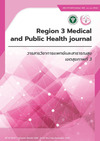การศึกษาเปรียบเทียบผลการรักษาผู้ป่วยโรคไตเรื้อรังระยะสุดท้าย ที่ล้างไตทางช่องท้องต่อเนื่อง ระหว่างกลุ่มที่เคยและไม่เคยได้รับการฟอกเลือดด้วยเครื่องไตเทียมฉุกเฉินมาก่อน
คำสำคัญ:
ล้างไตทางช่องท้อง, การฟอกเลือดด้วยเครื่องไตเทียมฉุกเฉิน, อัตราการรอดชีวิต, การคงอยู่ของอุปกรณ์, การติดเชื้อเยื้อบุช่องท้องอักเสบบทคัดย่อ
วัตถุประสงค์: เพื่อเปรียบเทียบอัตราการรอดชีวิต สาเหตุและปัจจัยที่ทำให้เสียชีวิต ระหว่างผู้ป่วยโรคไตเรื้อรังระยะสุดท้ายที่ได้ทำการล้างไตทางช่องท้องต่อเนื่องที่เคย และไม่เคยได้รับการฟอกเลือดด้วยเครื่องไตเทียมฉุกเฉินมาก่อน รวมทั้งเปรียบเทียบ อัตราการคงอยู่ของอุปกรณ์ล้างไตทางช่องท้อง (Tenckhoff catheter) และอุบัติการณ์การติดเชื้อเยื้อบุช่องท้องอักเสบ (CAPD Related peritonitis) ที่ต้องเปลี่ยนสายล้างไตทางช่องท้อง เพื่อนำมาพัฒนาคุณภาพการรักษา และการให้บริการ Peritoneal Dialysis ในอนาคต และเฝ้าติดตามผู้ป่วยโรคไตเรื้อรังระยะสุดท้าย ให้ได้เริ่มล้างไตทางช่องท้องอย่างรวดเร็ว ก่อนต้องทำการฟอกเลือดด้วยเครื่องไตเทียมฉุกเฉิน
สถานที่ศึกษา: หน่วยไตเทียม โรงพยาบาลสวรรค์ประชารักษ์
รูปแบบการวิจัย: การศึกษาย้อนหลัง (Retrospective cohort study)
กลุ่มตัวอย่าง: ผู้ป่วยไตวายเรื้อรังระยะสุดท้ายที่ได้รับการลงทะเบียนไว้ตั้งแต่วันที่ 1 มกราคม 2562 จนถึง 31 ธันวาคม 2564 ของโรงพยาบาลสวรรค์ประชารักษ์ จังหวัดนครสวรรค์ จำนวน 295 คน
วิธีการศึกษา: รวบรวมข้อมูลพื้นฐานผู้ป่วย ได้แก่ อายุ เพศ โรคร่วม โรคที่เป็นสาเหตุการเกิดโรคไตเรื้อรังระยะสุดท้าย และสาเหตุการการฟอกเลือดด้วยเครื่องไตเทียมฉุกเฉิน ข้อมูลผลการรักษา ได้แก่ วันเริ่มใส่อุปกรณ์ล้างไตทางช่องท้อง วันเริ่มใส่น้ำยาล้างไตทางช่องท้อง วันที่ยุติการล้างไตทางช่องท้อง วันที่เสียชีวิต ระยะเวลาการพักท้องหลังใส่อุปกรณ์ล้างไตทางช่องท้อง (Break-in period) วันที่เกิดการติดเชื้อเยื้อบุช่องท้องอักเสบ สาเหตุและปัจจัยที่ทำให้เสียชีวิต และสาเหตุการถอดอุปกรณ์ล้างไตทางช่องท้อง แบ่ง 2 กลุ่ม คือผู้ป่วยโรคไตเรื้อรังระยะสุดท้ายที่ทำการล้างไตทางช่องท้องต่อเนื่องเป็นครั้งแรกในช่วงที่ศึกษา (CAPD group) และผู้ป่วยที่ทำการล้างไตทางช่องท้องต่อเนื่องหลังจากทำการฟอกเลือดด้วยเครื่อง ไตเทียมฉุกเฉินมาก่อน (CAPD-following HD group) เปรียบเทียบข้อมูลพื้นฐาน และข้อมูลการรักษาทั้ง 2 กลุ่ม ได้แก่ ระยะเวลาตั้งแต่ล้างไตจนกระทั่งจบการศึกษาหรือผู้ป่วยเสียชีวิต ระยะเวลาตั้งแต่วันแรกที่ล้างไตจนยุติการล้างไตทางช่องท้อง สาเหตุ และปัจจัยที่ทำให้เสียชีวิต และ การติดเชื้อเยื้อบุช่องท้องอักเสบ ด้วยสถิติ Cox Proportional Hazard Regression, Fine & Gray’s proportional sub distribution hazard model, Kaplan-Meier plot, Fisher’s Exact test และ Risk regression นำเสนอขนาดของอิทธิพลของปัจจัยเสี่ยงด้วยค่า Hazard Ratio (HR) และค่าความเชื่อมั่นร้อยละ 95 (95% Confidence Interval: CI)
ผลการศึกษา: ค่ามัธยฐานของระยะเวลาการติดตามการรักษาอยู่ที่ 12 เดือน ผู้ป่วย CAPD group จำนวน 156 คน และผู้ป่วย CAPD-following HD group จำนวน 139 คน พบว่าภาพรวมข้อมูลพื้นฐานของทั้งสองกลุ่มไม่แตกต่างกัน ยกเว้นในผู้ป่วย CAPD group มีโรคร่วมเป็น Cerebrovascular Accident น้อยกว่า (ร้อยละ 5.1 และร้อยละ 13.7, P=0.01) และอัตราการรอดชีวิตของผู้ป่วย CAPD group และผู้ป่วยกลุ่ม CAPD-following HD group ไม่พบความแตกต่างอย่างมีนัยสำคัญทางสถิติ (HR=1.08, 95%CI=0.64-1.83, P=0.76) และจากการที่วิเคราะห์ด้วยวิธี Competing Risk Regression อัตราการเสียชีวิตสะสมของผู้ป่วยทั้งสองกลุ่ม ไม่พบความแตกต่างอย่างมีนัยสำคัญทางสถิติ (HR=1.09, 95%CI=0.66-1.83, P=0.73) Technique Survival ของผู้ป่วยทั้งสองกลุ่มไม่พบความแตกต่างอย่างมีนัยสำคัญทางสถิติ (HR=0.97, 95%CI= 0.54-1.75, P=0.92) ส่วนปัจจัยที่ทำให้เสียชีวิตพบว่า ผู้ป่วยที่มีอายุมากกว่า 60 ปี มีอัตราการเสียชีวิตเพิ่มขึ้น 1.84 เท่า อย่างมีนัยสำคัญทางสถิติ (HR=1.84, 95%CI=1.06-3.18, p=0.03) และผู้ป่วยที่มีโรคร่วมเป็นโรคเบาหวาน มีอัตราการเสียชีวิตเพิ่มขึ้น 2.05 เท่าอย่างมีนัยสำคัญทางสถิติ (HR=2.05, 95%CI=1.05-3.98, P=0.04) สุดท้ายอุบัติการณ์การติดเชื้อเยื้อบุช่องท้องอักเสบ ที่ต้องเปลี่ยนสายล้างไตทางช่องท้องของผู้ป่วยทั้งสองกลุ่ม ไม่พบความแตกต่างอย่างมีนัยสำคัญทางสถิติ (RR=0.90, 95%CI = 0.68-1.19, P = 0.47)
วิจารณ์และสรุป: อัตราการรอดชีวิต อัตราการคงอยู่ของอุปกรณ์ และอุบัติการณ์การติดเชื้อเยื้อบุช่องท้องอักเสบที่ต้องเปลี่ยนสายล้างไตทางช่องท้อง ของผู้ป่วยทั้งสองกลุ่ม ไม่พบความแตกต่างอย่างมีนัยสำคัญทางสถิติ พบว่า ผู้ป่วยที่มีอายุมากกว่า 60 ปี และ ผู้ป่วยที่มีโรคร่วมเป็นโรคเบาหวาน มีความเสี่ยงเสียชีวิตเพิ่มขึ้นอย่างมีนัยสำคัญทางสถิติ
คำสำคัญ: ล้างไตทางช่องท้อง, การฟอกเลือดด้วยเครื่องไตเทียมฉุกเฉิน, อัตราการรอดชีวิต, การคงอยู่ของอุปกรณ์, การติดเชื้อเยื้อบุช่องท้องอักเสบ
เอกสารอ้างอิง
Ingsathit A, Thakkinstian A, Chaiprasert A, Sangthawan P, Gojaseni P, Kiattisunthorn K, et al. Prevalence and risk factors of chronic kidney disease in the Thai adult population: Thai SEEK study. Nephrol Dial Transplant. 2010;25(5):1567-75.
Chuasuwan A. LA. THAILAND RENAL REPLACEMENT THERAPY YEAR 2020. ข้อมูลการบําบัดทดแทนไตในประเทศไทย พศ 2563. 2020.
สำนักงานหลักประกันสุขภาพแห่งชาติ. การบริหารงบบริการผู้ป่วยไตวายเรื้อรัง. คู่มือบริหารกองทุนหลักประกันสุขภาพแห่งชาติ. 2558.
Tu YR, Tsai TY, Lin MS, Tu KH, Lee CC, Wu VC, et al. Association between initial dialytic modalities and the risks of mortality, infection death, and cardiovascular events: A nationwide population-based cohort study. Sci Rep. 2020;10(1):8066.
Li WY, Wang YC, Hwang SJ, Lin SH, Wu KD, Chen YM. Comparison of outcomes between emergent-start and planned-start peritoneal dialysis in incident ESRD patients: a prospective observational study. BMC Nephrol. 2017;18(1):359.
Parapiboon W, Sangsuk J, Nopsopon T, Pitsawong W, Tatiyanupanwong S, Kanjanabuch T, Johnson DW. Randomized Study of Urgent-Start Peritoneal Dialysis Versus Urgent-Start Temporary Hemodialysis in Patients Transitioning to Kidney Failure. Kidney Int Rep. 2022;7(8):1866-77.
Sipahioglu MH, Aybal A, Unal A, Tokgoz B, Oymak O, Utas C. Patient and technique survival and factors affecting mortality on peritoneal dialysis in Turkey: 12 years’ experience in a single center. Perit Dial Int. 2008;28(3):238-45.
Chieochanthanakij R. Twelve. Years CAPD Outcomes in Peritoneal Dialysis Unit of Sawanpracharak Hospital Sawanpracharak medical journal. 2019;20.
Changsirikulchai S, Sriprach S, Thokanit NS, Janma J, Chuengsaman P, Sirivongs D. Survival Analysis and Associated Factors in Thai Patients on Peritoneal Dialysis Under the PD-First Policy. Perit Dial Int. 2018;38(3):172-8.
Collins AJ, Foley RN, Chavers B, Gilbertson D, Herzog C, Johansen K, et al. ‘United States Renal Data System 2011 Annual Data Report: Atlas of chronic kidney disease & end-stage renal disease in the United States. Am J Kidney Dis. 2012;59(1 Suppl 1):A7, e1-420.
de Jager DJ, Grootendorst DC, Jager KJ, van Dijk PC, Tomas LM, Ansell D, et al. Cardiovascular and noncardiovascular mortality among patients starting dialysis. JAMA. 2009;302(16):1782-9.
ดาวน์โหลด
เผยแพร่แล้ว
วิธีการอ้างอิง
ฉบับ
บท
การอนุญาต
ลิขสิทธิ์ (c) 2024 Region 3 Medical and Public Health Journal - วารสารวิชาการแพทย์และสาธารณสุข เขตสุขภาพที่ 3

This work is licensed under a Creative Commons Attribution-NonCommercial-NoDerivatives 4.0 International License.




